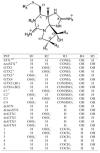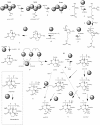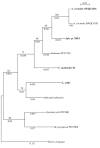Characterisation of the paralytic shellfish toxin biosynthesis gene clusters in Anabaena circinalis AWQC131C and Aphanizomenon sp. NH-5
- PMID: 19331657
- PMCID: PMC2679770
- DOI: 10.1186/1471-2091-10-8
Characterisation of the paralytic shellfish toxin biosynthesis gene clusters in Anabaena circinalis AWQC131C and Aphanizomenon sp. NH-5
Abstract
Background: Saxitoxin and its analogues collectively known as the paralytic shellfish toxins (PSTs) are neurotoxic alkaloids and are the cause of the syndrome named paralytic shellfish poisoning. PSTs are produced by a unique biosynthetic pathway, which involves reactions that are rare in microbial metabolic pathways. Nevertheless, distantly related organisms such as dinoflagellates and cyanobacteria appear to produce these toxins using the same pathway. Hypothesised explanations for such an unusual phylogenetic distribution of this shared uncommon metabolic pathway, include a polyphyletic origin, an involvement of symbiotic bacteria, and horizontal gene transfer.
Results: We describe the identification, annotation and bioinformatic characterisation of the putative paralytic shellfish toxin biosynthesis clusters in an Australian isolate of Anabaena circinalis and an American isolate of Aphanizomenon sp., both members of the Nostocales. These putative PST gene clusters span approximately 28 kb and contain genes coding for the biosynthesis and export of the toxin. A putative insertion/excision site in the Australian Anabaena circinalis AWQC131C was identified, and the organization and evolution of the gene clusters are discussed. A biosynthetic pathway leading to the formation of saxitoxin and its analogues in these organisms is proposed.
Conclusion: The PST biosynthesis gene cluster presents a mosaic structure, whereby genes have apparently transposed in segments of varying size, resulting in different gene arrangements in all three sxt clusters sequenced so far. The gene cluster organizational structure and sequence similarity seems to reflect the phylogeny of the producer organisms, indicating that the gene clusters have an ancient origin, or that their lateral transfer was also an ancient event. The knowledge we gain from the characterisation of the PST biosynthesis gene clusters, including the identity and sequence of the genes involved in the biosynthesis, may also afford the identification of these gene clusters in dinoflagellates, the cause of human mortalities and significant financial loss to the tourism and shellfish industries.
Figures





Similar articles
-
Variability in the sxt Gene Clusters of PSP Toxin Producing Aphanizomenon gracile Strains from Norway, Spain, Germany and North America.PLoS One. 2016 Dec 1;11(12):e0167552. doi: 10.1371/journal.pone.0167552. eCollection 2016. PLoS One. 2016. PMID: 27907126 Free PMC article.
-
Molecular and morphological survey of saxitoxin-producing cyanobacterium Dolichospermum circinale (Anabaena circinalis) isolated from geographically distinct regions of Australia.Toxicon. 2017 Nov;138:68-77. doi: 10.1016/j.toxicon.2017.08.006. Epub 2017 Aug 7. Toxicon. 2017. PMID: 28797629
-
Paralytic shellfish poisoning toxin-producing cyanobacterium Aphanizomenon gracile in northeast Germany.Appl Environ Microbiol. 2010 Feb;76(4):1173-80. doi: 10.1128/AEM.02285-09. Epub 2010 Jan 4. Appl Environ Microbiol. 2010. PMID: 20048055 Free PMC article.
-
Paralytic shellfish toxin biosynthesis in cyanobacteria and dinoflagellates: A molecular overview.J Proteomics. 2016 Mar 1;135:132-140. doi: 10.1016/j.jprot.2015.08.008. Epub 2015 Aug 25. J Proteomics. 2016. PMID: 26316331 Review.
-
Neurotoxic alkaloids: saxitoxin and its analogs.Mar Drugs. 2010 Jul 20;8(7):2185-211. doi: 10.3390/md8072185. Mar Drugs. 2010. PMID: 20714432 Free PMC article. Review.
Cited by
-
An overview on the marine neurotoxin, saxitoxin: genetics, molecular targets, methods of detection and ecological functions.Mar Drugs. 2013 Mar 27;11(4):991-1018. doi: 10.3390/md11040991. Mar Drugs. 2013. PMID: 23535394 Free PMC article. Review.
-
Comparative transcriptome analysis of a toxin-producing dinoflagellate Alexandrium catenella and its non-toxic mutant.Mar Drugs. 2014 Nov 24;12(11):5698-718. doi: 10.3390/md12115698. Mar Drugs. 2014. PMID: 25421324 Free PMC article.
-
Chemoenzymatic Total Synthesis of Natural Products.Acc Chem Res. 2021 Mar 16;54(6):1374-1384. doi: 10.1021/acs.accounts.0c00810. Epub 2021 Feb 18. Acc Chem Res. 2021. PMID: 33600149 Free PMC article. Review.
-
Saxitoxin: A Comprehensive Review of Its History, Structure, Toxicology, Biosynthesis, Detection, and Preventive Implications.Mar Drugs. 2025 Jul 2;23(7):277. doi: 10.3390/md23070277. Mar Drugs. 2025. PMID: 40710502 Free PMC article. Review.
-
Biocatalytic Detoxification of Paralytic Shellfish Toxins.ACS Chem Biol. 2019 May 17;14(5):941-948. doi: 10.1021/acschembio.9b00123. Epub 2019 Apr 15. ACS Chem Biol. 2019. PMID: 30983320 Free PMC article.
References
-
- Kaas H, Henriksen P. Saxitoxins (PSP toxins) in Danish lakes. Water Research. 2000;34:2089–2097. doi: 10.1016/S0043-1354(99)00372-3. - DOI
-
- Kao CY, Levinson SR, eds . Tetrodotoxin, saxitoxin, and the molecular biology of the sodium channel. New York: The New York Academy of Science; 1986. - PubMed
-
- Chang Z, Sitachitta N, Rossi JV, Roberts MA, Flatt PM, Jia J, Sherman DH, Gerwick WH. Biosynthetic pathway and gene cluster analysis of curacin A, an antitubulin natural product from the tropical marine cyanobacterium Lyngbya majuscula. Journal of Natural Products. 2004;67:1356–1367. doi: 10.1021/np0499261. - DOI - PubMed
MeSH terms
Substances
Associated data
- Actions
- Actions
- Actions
LinkOut - more resources
Full Text Sources
Other Literature Sources
Molecular Biology Databases

